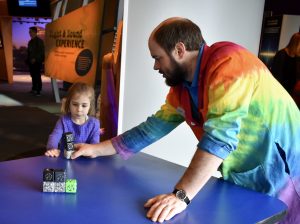The World Has Become Colorful Again
The world around usa is full of amazing colors. Whether your favorite is ruby, blueish, greenish, orange, or somewhere in betwixt, y'all can always find something that suits your taste. Only did you know that calorie-free plays a big role in the colors that we see?
In this video, watch us explore how irresolute the color of a calorie-free can change what color nosotros think an object is. Check it out, and you can try information technology at domicile as well.
Materials to Collect
- Colour changing light or colorful LED Strip
- Colorful objects
- A dark room, or coating fort
- Cellophane, markers, and flashlights
Build/Brand Your Own/Attempt it Out
- Find some color changing lights, or make your ain by coloring in cellophane with a marker and placing information technology over the end of a flashlight.
- Gather some colorful objects and plough off all of the lights in a room or build a blanket fort that you can crawl into and have it exist nice and nighttime. To work well, it will need to exist very dark, so you might want to endeavour this out at night.
- Smoothen unlike color lights onto objects and lookout man as the colors alter. Attempt it out with every color that you tin.
What is the Science?
If you have ever seen white lite polish through a prism or looked at a rainbow in the sky, you take observed that white light contains all the colors of the rainbow.
When we await at an object and run across its color, we are seeing all of the light that reflects off of that object. Cherry-red objects reflect red lite, light-green objects reverberate light-green light, so on. But what happens to the rest of the colors that hit that object? They get captivated! If you have a cherry object, all the orange, yellow, green, blue, and violet low-cal gets absorbed into that object. If you lot have a black object, virtually all of the light gets absorbed by that object.
Since we are talking virtually objects and how they reverberate light, it might help to recollect of these objects equally color mirrors. A bluish object acts like a "blue mirror." We merely come across what is being reflected dorsum to us, in this case it'south blue! So what happens if you shine simply cerise light onto a bluish object? All of that red low-cal gets captivated and the bluish object will seem to be night, virtually black. If you now shine a blue calorie-free onto that blue object all the blue can reverberate off of that "blue mirror" and you volition run across the colors again!
Ask Your Young Scientists
Equally yous are changing the colors of light on your objects, ask your scientist what they notice well-nigh all the colors. What do they notice if they focus on 1 object/color at a time? What happens when you polish more than one color light at a time? What practise you notice when and so lite matches the color of the object. What practice you notice when the light doesn't friction match the object'due south color?
More than to Explore
Endeavour a fun game:
- Grab some different colored markers or paints and try to describe a picture while y'all only have one color of light shining on your artwork and tools. Does it expect like yous thought information technology would when you change the light back to normal?
- Grab a bunch of colorful pieces, like Lego or candy. Can you sort them into piles past color if you only have red lights on? Is it easier or harder with a dissimilar colour?
We want to encounter what you try at home. Share your creation with us past tagging @CTScienceCenter and using the #ScienceAtPlay on social media for a chance to be featured.

Nate Gagnon is a Public Programs Educator at the Connecticut Scientific discipline Eye. In his role he creates heady educational programs and demonstrations that highlight science and STEM careers. You can find him in our galleries with fun activities that you and your family unit tin can enjoy.

Andrew Fotta is a STEM educator at the Connecticut Science Center. He has currently holds a CT teaching certification for grades K-six, and has spent time in the classroom in nigh all grades, and taught centre school science. In addition to teaching classes for the Science Center, Andrew is likewise function of a team of educators currently creating new programs aligned with the new Next Generation Science Standards for grades PreK-9. Andrew is an avid photographer, who enjoys blending scientific discipline and art in his work.
Source: https://ctsciencecenter.org/blog/science-at-play-change-the-color-of-the-world-around-you/
0 Response to "The World Has Become Colorful Again"
Post a Comment